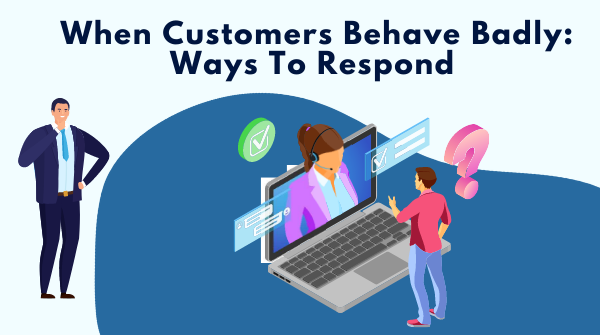When Customers Behave Badly: Ways To Respond

Conflict is unavoidable in human relationships. And, unfortunately, even minor conflicts can quickly escalate when there’s money involved. This is true even if you’re a small business owner whose primary goal is to provide great service for your customers.
Customer expectations are evolving rapidly, with 57% of survey respondents reporting that they will switch to a competitor after only one bad experience. These rising expectations are a normal result of today’s increasingly online, on-demand world. It seems like every market is a buyer’s market, making it harder for merchants to satisfy customers.
This article outlines:
- The types of customer issues you might face
- Why these conflicts may arise
- How best to resolve them before they get worse
Why do customers get upset?
No two conflicts are the same, but most problems arise from a combination of variables – in and outside of your direct control.
For example:
- Many customers may become frustrated as a result of personal issues. Traffic jams, a bad day at work, or trouble at home are all common reasons. While there isn’t a whole lot you can do to resolve these problems, there are steps you can take to help minimize their impact on your small business.
- Other times, customers might disagree with a company policy you have – such as not accepting personal checks or the terms for returning an item. These are technically within your control. That said, if there’s a good reason for a policy to exist, you shouldn’t feel bad about enforcing it.
- Finally, there are customers who become angry due to poor customer experiences – stemming from low-quality products, bad customer service, or a combination of both.
How do you resolve these types of issues as they occur?
Conflict resolution tips for small business owners
The next time you’re dealing with an unruly or difficult customer, try using the strategies listed below to help resolve the underlying issue as quickly as possible.
1. Stay calm
Remaining calm is one of the most important tips in life and in business. In fact, getting angry will almost always make the situation worse. Staying calm can be challenging – particularly when an irate customer is yelling at you. One thing that helps is to remember in these situations that it’s rarely personal. The customer is more likely to be upset at the situation and not at you, the individual.
2. Listen carefully
Active listening allows you to better understand the issue, which increases your ability to help resolve whatever problem the customer is facing. Listening also allows customers to vent, which can often help deescalate the situation. Sometimes, people just need to blow off steam.
3. Restate the problem
The next step involves repeating the underlying issue back to the customer – in your words. This lets the customer know that you understand them and that you’re on the same page:
- If your initial interpretation is wrong, the customer will let you know immediately.
- If your interpretation is correct, you’ll have established some empathy and rapport, which makes the next steps much easier to implement.
4. Deescalate the situation
The next goal is to deescalate the issue as quickly as possible. However, it’s important to understand what the issue is – which is why listening and remaining calm are so foundational to conflict resolution.
If you or the business is at fault, apologize immediately and work to make things right. For example, if a package arrived damaged, then you may want to consider sending a free replacement, paying for return shipping, or offering the customer a discount on their next purchase.
Customers will respect you more if you immediately accept responsibility and try to make amends. Admittedly, some customers will try to game the system to squeeze more concessions from you. We’ll discuss this type of customer in the final tip below.
If the customer is at fault, don’t assign blame. Instead, calmly explain any relevant company policies – and why they exist. Again, there will always be a certain fraction of customers who aren’t interested in resolution. Some will actively resist any good-faith gestures you make.
The final tip explains how to deal with those in this category.
5. Terminate bad customer relationships
According to the 80/20 rule, 80% of all outcomes come from 20% of all causes. In conflict resolution terms, this means 20% of your customers consume a disproportionate amount of your time and resources. You may be better off letting them go. Doing so allows you to devote more of your attention to customers who add value to your business.
However, there’s no need to be rude about it. It only risks making the situation worse.
Instead, calmly encourage difficult customers to comply with company policies or accept whatever compensation you’re prepared to offer. If they refuse, ask them to leave. Letting a dissatisfied customer go doesn’t mean you’re losing a past sale. It means you are protecting yourself from future disruptions and hassles.
Although customer conflicts come in all shapes and sizes, communication is the key to resolving most issues:
- Sharing information through clear policies, social media updates, and newsletters allows you to manage expectations more effectively.
- Listening to your customers makes them feel like their voices are being heard.
These two skills come naturally to some, less so to others. This is why employee training is so important. When everyone on the team understands the above strategies, customer conflicts become less frequent – and easier to manage.

